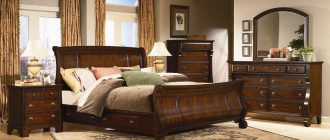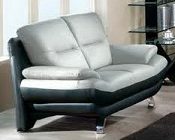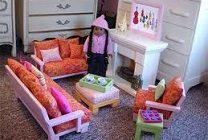With the establishment of her great trade in the East, and in the West Indies, Holland rapidly became the richest nation in Europe. This wealth was not centralized in the larger cities, but extended to landowners of outlying districts, where it was still apparent after the decline of Dutch power in the late seventeenth century and a final collapse during the ensuing decades.
Designs of native furniture are by no means graceful, facile, subtle or dainty. They are, however, often decidedly virile, presenting handsome effects that may approach a certain delicacy in the more refined compositions. There is always a feeling of sturdiness and restraint, the latter quality extending to elaborate sculptured features. Sobriety and dignity and, wherever possible, economy and usefulness in everyday life, were more often achieved by Dutch designers and craftsmen.
Throughout the seventeenth century, designs in Holland inspired work of all neighboring countries, particularly in northern Europe and England. Although Holland had previously derived some influence from France, this impetus became more active during the eighteenth century, when, after 1730, furniture and decorations in Holland were propelled by French Rococo developments. This influence later spread as far north as Friesland, where the more important edifices were richly paneled and furnished to suit the mode. Louis XVI designs were also closely followed, while Directoire and Empire projects in Holland were sometimes fashioned with principal elements derived through French motivation.
Interpretations of French seat furniture were more accurately rendered than cabinetwork, while artisans concerned with both branches of furniture-making continued to work in native styles throughout the periods of Gallic influence.
Dutch lacquer cabinets, copied from examples obtained in China and Japan, were popular in Holland and England during the late seventeenth and early eighteenth centuries. These were mounted upon gilded or silvered stands, designed and – carved in native styles, or indicating French Louis XIV and Regence influences. Both cabinets and stands of this type are often mistaken for English products today. Throughout the balance of the eighteenth century, lacquer techniques in Holland continued to develop, approaching advances made in France and Germany, in contrast to the quality of this work commonly found in English specimens.
Holland had been largely responsible for the rise of furniture crafts in England during the seventeenth century, and continued to exert influence in this direction through the following decades. However, despite her commercial ties with England, and the emigration of Dutch workmen to that country, English furniture designs never affected those of Holland to any appreciable degree. This is additionally remarkable, as English furniture was imported during the eighteenth century. These importations, and others obtained from France, were marked with a prescribed stamp, which appears in the form of a coroneted shield enclosing a row of crosses, and flanked by the letters ”J” and “G.”
Furniture which has been lightly regarded as “William and Mary,” “Queen Anne” or “Early Georgian” was executed during extended periods of popularity in Holland, often accompanied by later elements of ornamentation. These baroque forms will be found with rococo, or even classic details. The fixed rule, that a piece of furniture be dated only according to its latest feature of design, is often disregarded in ascribing dates to such examples. This phenomenon is particularly apparent in seat furniture, where seventeenth century forms were continued well into the following era, while “Queen Anne” features appear in Dutch examples made during the second half of the eighteenth century.
Design influences from Holland penetrated far into the eastern and southern states of Germany, and through Scandinavia, during the first half of the eighteenth century. Examples produced under this influence have been readily accepted as of Dutch provenance, adding further to a misunderstanding which has also accepted Irish examples, and those executed in England by Dutch craftsmen, in the category of Dutch furniture.
As the Dutch were carriers for much of the trade in Europe, cargoes of exotic timbers brought home by their ships served to introduce these in neighboring vicinities, and thus to affect local productions of furniture. While palisander, ebony and lignum-vitae were imported during the seventeenth century, mahogany did not come into general use in Holland, France, Scandinavia or Germany until the middle of the following era. This delayed adoption, on the Continent, of such a superior medium for the construction and preservation of furniture, is sometimes of service in considering examples which are related to English designs.
In addition to other distantly acquired timbers, such as rosewood, padouk, satinwood, etc., the Dutch utilized oak, walnut, elm, ash, pine, beech, sycamore and fruit-woods in their furniture. Elaborate marquetry work and banded inlays were enhanced with tortoise shell, ivory, brass, pewter and silver.
The Hollanders also bought up large quantities of timber on the Continent, much of which passed through Dordrecht, a center for this trade, with many sawmills operating there during the eighteenth century. Hindeloopen mariners supplied additional timbers from Scandinavia to Amsterdam and smaller ports. Native supplies of forest trees, never abundant in Holland, had become so depleted during the nineteenth century as to consist of only a few plantations of oak, beech and elm, clumps of pine on the links or sand drifts, and rows of willow and poplar along the banks of canals.
Regulation in Holland stipulated use of oak for secondary work in veneered pieces made by cabinet-workers, a medium also favored for carved mirror frames and architectural treatments, though here linden and pine are also to be found. The use of pine, imported or domestic, together with other soft whitewoods, was restricted to a separate guild of cabinetmakers, referred to as whiteworkers, for constructing pieces that were to be finished with painted or lacquered decorations.





